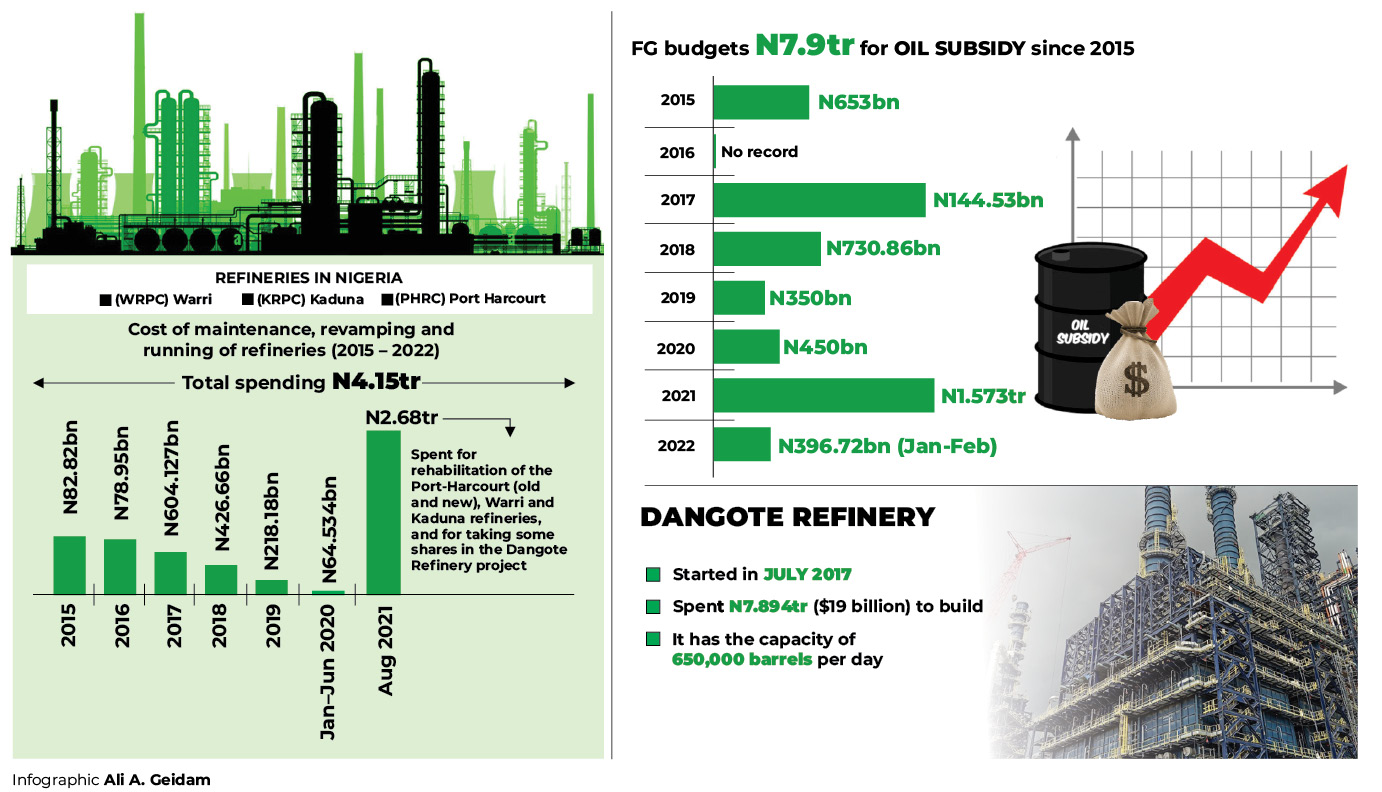The N12.05 trillion spent by the federal government on maintenance and rehabilitation of refineries, as well as fuel subsidy in seven years, is more than enough to build a brand new 650,000 barrels per stream day (bpsd) refinery and another 325,000bspd refinery, an investigation by Daily Trust on Sunday has shown.
Such new refinery would have been bigger than the three moribund refineries built many years ago.
Over time, the refineries had guzzled billions of naira in the name of “upkeep”, and yet, could not produce any refined oil for domestic consumption.
The three refineries have a combined 445,000bpsd capacity. Port Harcourt refinery complex (old and new site) has 210,000bpsd, Warri has 125,000bpsd and Kaduna has 110,000bpsd capacity.
The collective failure of the refineries had forced the oil-rich Nigeria to depend on importing refined petroleum products after exporting the crude.
Sadly, a large chunk of dollars accrued to Nigeria is being used to import the refined oil for domestic use, obstructing channelling the funds for social and economic development.

The deep, endless hole
By the end of the 2022 fiscal year, the federal government would have spent N12.05trillion since 2015 on refineries’ repairs and fuel subsidies.
This is according to data sourced from the Nigerian National Petroleum Company Limited (NNPCL).
While N7.9trn is on petrol subsidy, another N4.15trn went for maintaining and rehabilitating the three refineries since 2015.
An analysis of the N4.15trn refinery spending shows that N1.47trn was spent on maintaining, revamping and running the three refineries from 2015 to June 2020.
The government, in August 2021, announced $6.46billion (about N2.68tr) spending for the rehabilitation of the Port Harcourt (old and new) at $1.5bn (N622.9bn), Warri refinery at $900m (N373.8bn) and Kaduna refinery at $1.3bn (N540bn), and for taking 20 per cent shares in the Dangote Refinery project at $2.76bn (N1.146trn).
The Minister of State for Petroleum Resources, Timipre Sylva, in April 2022, said the $1.5bn rehabilitation work for the old Port Harcourt refinery would be completed by April 2023 to start refining 60,000bpsd of crude; though the entire complex has 210,000bpsd capacity.
Similarly, an analysis of the N7.9trn petrol subsidy fund indicates that although there was no spending record for 2016, at least N2.329trn was spent between 2015 and 2020 subsidising petrol. Rising higher, another N1.573trn was spent in 2021.
And for the 2022 fiscal year, the government has just approved N4trn budget. Out of this, the NNPCL had spent N675.9bn to subsidise petrol to remain at N165 per litre for January to March 2022.
At the moment, the three refineries in Port Harcourt, Rivers State; Warri, Delta State; and Kaduna, Kaduna State, with a combined 445,000bpsd capacity, are inoperative.
And although they operated up till 2017, they were not at the optimal level. According to a 13-month NNPC data from November 2016 to November 2017 when the refineries were operational, they had operated below 42 per cent despite the huge sum spent on them.
Port Harcourt refinery worked for 11 months and was idle for two months; its highest capacity was 40 per cent as at February 2017. Warri refinery worked for seven months and was idle for six months. It hit 42 per cent operation in January 2017, which was the highest recorded by the three refineries. Kaduna refinery operated for five months and lost eight months idling. It delivered 34 per cent in February 2017 as its highest.
By November 2017 during temporary fuel scarcity, only the Warri refinery operated at 21 per cent, the two others were shut, the data revealed. The three refineries supplied 1.6bn litres of petrol out of 15.1bn litres obtained from domestic and offshore importation platforms within the 13 months. They also supplied 707.87 million litres of kerosene, from the 854.3m entire supply.
While they produced 83 per cent of kerosene consumed in 2016 and 2017, they only produced 11 per cent of the entire petrol consumed during the 13 months. At the end of 2017, the refineries were shut down after performing below 30 per cent of their installed capacity, according to the NNPC data.
Shining examples from far and near
Despite Nigeria being Africa’s largest crude oil producer, it relies on Belgium and others to refine its crude.
There are 18 oil-producing countries in Africa, based on March 2022 data by Trading Economics, a global market website.
Nigeria is the largest of them with 1,238million bpsd oil production, overtaking Libya (1,220mbpsd). Angola is the third, Algeria is fourth and Egypt is fifth (562m bpsd).
The rest have less than 500,000bpsd oil production each, comprising Congo DR, Gabon, Ghana, Equatorial Guinea, Sudan, Chad, Cameroon, Ivory Coast, Tunisia, Congo Brazzaville and Niger Republic.
According to a McKinsey Refinery Capacity Database of 2020, there were over 600 operating refineries around the world as at the beginning of 2017. As at 2020, 20 African countries had refineries, with some countries having more than one.
The McKinsey data revealed that Antwerp city in Belgium hosts the three refineries with 767,000bpsd that Nigeria patronises. These Belgium refineries are owned by ExxonMobil (307,000bpsd), Total (350,000bpsd) and Gunvor (110,000bpsd), and both Mobil and Total are International Oil Companies (IOCs) operating in Nigeria in a joint venture with the NNPC Ltd.
In Africa, Morocco does not produce oil but has a 200,000bpsd refinery; same with Zambia with no oil but has a 12,000bpsd refinery.
Although Egypt is the fifth oil producer, it has nine refineries with 800,000bpsd, being the largest refining capacity in Africa. Algeria, the fourth largest African oil producer has five refineries refining 671,000bpsd; Libya, the second producer also has five refineries with 380,000bpsd; Angola, the third largest African oil producer has one but operational refinery of 65,000bpsd.
Niger Republic, Cameroon, Ivory Coast, Ghana and Liberia’s combined oil-producing capacity is less than half of Nigeria’s oil-producing capacity, yet they each have an operational refinery.

Behold the Dangote refinery
The 650,000bpsd Dangote Refinery in Lagos is expected to gulp $19bn (about N7.894tr) when completed.
This was announced by the president of Dangote Industries Limited, Aliko Dangote, at a briefing at the refinery site in January 2022.
When complete, it will be the largest single-train refinery in the world.
The refinery is situated on a 6,180 acres (2,500 hectares) site at the Lekki Free Zone, Lekki, Lagos State. The crude oil will be transported via pipelines from oil fields in the Niger Delta, where natural gas will also be sourced to supply the fertilizer factory and be used in electrical generation for the refinery complex.
At full production, handlers of the project said the facility would be able to produce 50,000,000 litres (13,000,000 US gal) of gasoline and 17,000,000 litres (4,500,000 US gal) of diesel daily, as well as aviation fuel and plastic products.
Experts said the federal government could have channelled the nearly N12trn fund it had expended on the three moribund refineries and subsidies to build two refineries with 975,000bpsd combined refining capacities.
The first refinery would be 650,000bpsd like the Dangote’s, gulping N7.9trn, while the second refinery would be a 325,000bpsd refinery, costing N3.95trn.
This will be a combined cost of N11.85trn, which is less than the N12.05trn the government has already pushed into refinery and subsidy spending in seven years.
With two new state-of-the-art refineries, Nigeria would have a refining capacity double the three old refineries at 890,000bpsd and an extra 85,000bpsd.
We’ve got a lot to learn – Experts
Some experts, industry operators and oil marketers spoke to Daily Trust on Sunday on the implications of relying on other countries for refined petroleum products.
Speaking about the implications, a financial analyst and former head of investor relations at the United Bank for Africa Plc, Abiola Rasaq, said the news of government refurbishing refineries had been the same rhetoric from one regime to another for about two decades.
“At some point, it was a story of turnaround maintenance on a refinery that is known to be moribund, and we just keep throwing in scarce resources into these heritage refineries without success.
“I am afraid the funds that have been purportedly spent turning around or refurbishing the refineries are more than what is required to build new ones if genuinely we hope to solve this problem.

“It is like a big elephant in the room and every player gets stuck every time an attempt is made to solve the puzzle,” he said.
He wondered why governments could not build a single refinery in modern times, even when an individual attempted it and was successful.
He said, “Despite the challenges and size of the Dangote Refinery, everyone can see the impressive progress. And many businesses have benefitted from even the ongoing construction works over the past five to six years, including the employment opportunity it has created alongside the development of the host communities.
“We cannot say that for the publicly-owned refineries, yet the government continues to waste resources on the assets.”
He also queried government’s huge spending “on subsidising petrol to the tune of N4trn or almost $10bn in just one year if what is required to either fix the refinery or build new ones is perhaps less than this. However, it is better late than never since this is our reality.”
On the way forward, he said government should reconsider the botched attempt to privatise the refineries, like the case of Benue Cement Company, which is now Dangote Cement Plc.
Another industry expert and former chairman of the Society of Petroleum Engineers (SPE), Emeka Ene, said only local refineries could salvage Nigeria’s reliance on fuel import.
He said. “We export a lot of oil and import petroleum products; and we have an issue in between. The first major shift is the commissioning of the Dangote Refinery. The second shift is the adoption of gas as an alternative fuel because if you look at countries like Argentina, India, Italy, there are more natural gas-driven vehicles than petrol-driven vehicles.”
On his part, the executive secretary of the Major Oil Marketers Association of Nigeria (MOMAN), Clement Isong, admitted that indeed, the federal government had spent huge amounts on fuel subsidy.
Isong stated that the amount spent on subsidies in the last seven years was enough to build a refinery and construct some social infrastructures, which would mitigate the effect of the removal of subsidy on the masses.
Ochube Onuh, an energy engineer, said Nigeria was yet to fully recover from the crisis of the adulterated petrol imported, which wouldn’t have happened if its refineries were working.
He said, “You remember how the situation worsened in March, and when the NNPC tried to withdraw the product, there was a record fuel scarcity.
“Some people are still nursing the injuries of how the petrol damaged their vehicles. This is why the government needs to declare an emergency on refineries by building new ones,” Onuh said.
Reps probe 10-year refineries’ rehab expenses
As the rage continues, the House of Representatives recently requested details of contracts awarded for the rehabilitation of the refineries for the past 10 years.
The committee in charge of the probe also queried the NNPC over the full payment of $3.7bn to refineries’ rehabilitation contractors without commensurate results.
The lower chamber of the National Assembly said the NNPC awarded the rehabilitation of Port Harcourt refinery at $1.5bn, Warri at $900m and Kaduna at $1.3bn. They also sought copies of annual budgets for the rehabilitation of the refineries since 2012.
The Group General Manager of the NNPCL, Group Public Affairs Department, Garba Deen Muhammad, did not respond to Daily Trust on Sunday’s enquiry on why the company elected to continue putting money into petrol subsidy, as well as spending hugely to rehabilitate the refineries when it could build new ones and refine products locally.
By Vincent Nwanma, Simon E. Sunday (Abuja), Eugene Agha & Abdullateef Aliyu (Lagos)

 Join Daily Trust WhatsApp Community For Quick Access To News and Happenings Around You.
Join Daily Trust WhatsApp Community For Quick Access To News and Happenings Around You.



